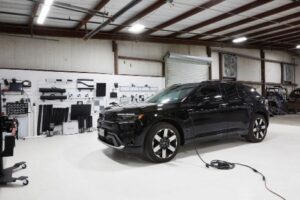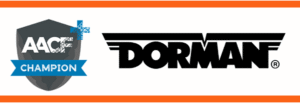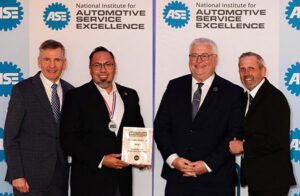This fictional auto repair story reimagines the roles of an OEM, an independent repair shop, and a consumer in the era of data-driven vehicles
Chapter 1: The secretive light
Sarah loved her new car, a sleek, connected vehicle with all the latest features. She embraced the convenience of its built-in navigation, blind-spot warnings, and fuel-finding app, signing up for all the connected services the dealership offered. She thought of it as a modern Perk — the digital extension of her new car.
For a while, everything was great. Then, the automated offers started.

Her car ran like a dream until the engine light flickered on for a moment before disappearing. The car seemed to drive fine, so Sarah ignored it. A week later, the light flashed again, and a digital notification appeared on her dashboard: “Critical Performance Anomaly Detected. Alerting ABC Auto Motors.”
The digital notice was unnerving, but the consequences that followed were truly alarming. The next day, she received an email from her health insurance provider promoting a “personalized” wellness program. They encouraged her to walk more and drive less, citing her “frequent and extensive vehicle usage” as a concern.
Alarm bells went off in her head when a credit card company offered her a special low-interest loan, referencing her car’s odometer readings and suggesting her daily commute was leading to “accelerated depreciation.”
Confused and uneasy, Sarah took her car to Mike, her family’s favorite mechanic for decades. Mike, a seasoned veteran, found his diagnostic tools blocked. The car’s computer system showed a digital lock icon, and a message on his screen read, “Diagnostic access denied. Please contact authorized service center.”
Chapter 2: The proprietary lock-in
Mike called ABC Auto technical support line. A representative informed him that only official dealerships could view the car’s full diagnostic data. “Our vehicles wirelessly transmit real-time performance metrics to us,” the representative explained. “We use it for your safety and to improve our products. The data belongs to us.” Mike tried to argue, but the conversation went nowhere. The corporate voice on the other end was immovable.
Five days later, Sarah received an email from ABC Auto offering an “enhanced warranty,” specifically citing her “recent engine performance issues.” The connection clicked into place: her car had been secretly feeding data to the auto shop. Without her explicit consent, her driving data was hacked and sold, locking her out of independent repair and into a predatory service loop.
Chapter 3: The call for control
After learning her car was spying on her and that her privacy was being exploited, Sarah realized her situation was more than a simple repair issue. Her options seemed limited: she could have someone adjust her car’s privacy settings, but she worried about potential consequences, or she could simply be helpless against the system.
This experience gave her a new perspective on a proposed piece of legislation: the Auto Data Privacy and Autonomy Act. The bill would help drivers like her regain control. It would ensure that manufacturers obtain explicit, opt-in consent for data usage and prohibit the sale or lease of this data without permission. It would also include protections against sharing sensitive information with foreign governments.
This legislation was no longer an abstract political idea for Sarah. It was the potential solution to her very personal and invasive problem, a way to move from a system of unclear, predatory practices to one where owners were in control of their own data.
Chapter 4: The final tune-up
With the new legislation in place, Sarah returned to Mike’s shop. This time, she brought a small, standardized On-Board Diagnostics device that is required to be compatible with any vehicle. She connected the device to her car’s diagnostic port, and the interface displayed a user-friendly dashboard of her car’s data.
With her explicit permission, Mike accessed the data, quickly diagnosed the problem as a simple, non-calibrated sensor, and fixed it affordably.
The flood of targeted offers stopped. Her car was once again simply her car and tool for transportation rather than a source of invasive surveillance. The Auto Data Privacy and Autonomy Act had put the owner back in the driver’s seat of personal information, transforming her relationship with her vehicle from one of exploitation to one of true ownership. ABC Auto could no longer secretly watch her driving or profit from her personal information.
Epilogue: The road ahead
The Auto Data Privacy and Autonomy Act accomplished more than just individual protection. It established a new era of transparency and fairness in the automotive industry.
• Increased transparency: It directs the FTC to report to Congress on data collection practices, shedding light on how auto manufacturers collect and use consumer data. Automakers and insurance companies must now send annual reports detailing their data collection practices.
• Freedom from proprietary lock-in: The legislation made it easier for owners to access and use their vehicle data without having to pay a fee or buy a special device from the manufacturer.
• Cybersecurity standards: The bill mandates that the FTC, in coordination with the National Institute of Standards and Technology (NIST), establish secure, technology-neutral standards for vehicle data interfaces. This helps ensure that granting access to data does not compromise vehicle cybersecurity and protects against malicious hacking.
Takeaway: This modern automotive tale underscores the need for clear data ownership and privacy regulations in an increasingly connected world. When drivers and nonpartisan auto shops are given control over personal information, any parts, service, or repair concerns can return to one of trust and transparency, benefiting everyone involved.
H.R. 10473 (118th): Auto Data Privacy and Autonomy Act Auto Data Privacy and Autonomy Act (2024; 118th Congress H.R. 10473) – GovTrack.us
Steven E. Schillinger is an accredited Professional Engineer and often speaks at auto industry meetings about EPA, OSHA and Fire Marshal regulations. He is certified for ANSI/ASHRAE/USGBC/IES Standard 189.1-2014 and works with companies to resolve and remove environmental, health and safety violations.









Comments are closed.